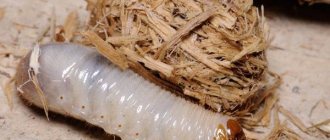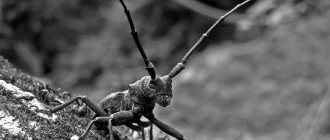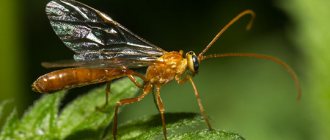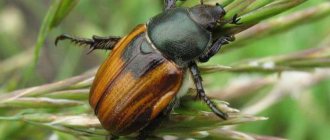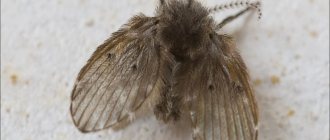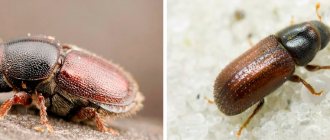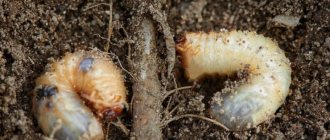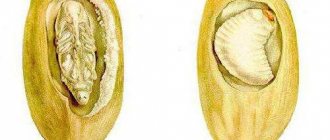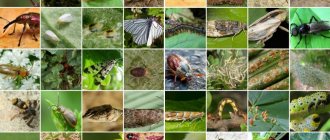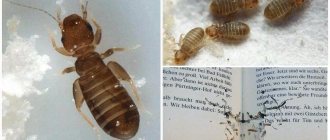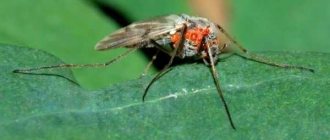Until recently, gardeners and flower growers had no idea about such a scourge.
The hairy deer (Tropinota (Epicometis) hirta) , also known as the hairy bronze deer (there are others, not hairy ones), was an inhabitant of the steppe zone.
However, global warming has made it possible for the pest to significantly move north.
The pest is not easy, but it can and should be fought. There are several bronzes. The hairy bronzer is a particular nuisance for the middle zone.
Lifestyle and habitat
The hairy deer beetle is a flower beetle from the lamellar beetle family.
This is an insect large enough for beetles, preferring to settle in steppe and forest-steppe zones. A lot of insects of this species can be found in the Crimea and the Caucasus. The insect is considered a flower beetle. The beetles are most active during the daytime from 10 a.m. to 3 p.m.
They spend the winter in deep earthen burrows, from which they begin to emerge in early spring. The first plant victims of the hairy deer are dandelions and coltsfoot. These plants begin to bloom earlier than others. Then the insects move into flowering gardens, strawberry beds and shrubs.
The peak of damage caused by insects occurs in May-June. Along with flowers, beetles can eat young foliage. They also readily attack blooming sunflower and rye crops. You can meet hairy deer in flower beds and greenhouses. After 18 hours their activity stops, the insects go to rest.
The hairy deer lays its larvae in the ground. Their size can reach 3 cm in length. They feed on rotten wood and plant roots. The beetles emerge from the larvae by mid-August. In nature, they have natural enemies - birds. From 30 to 60% of the hairy deer population dies from low temperatures. The eggs laid by insects are devoured by predatory moths and rove beetles.
Biological features
Reproduction in insects is bisexual.
The development cycle is complete. The hairy bronzer gives one generation per year.
Damages all vegetative and generative organs of plants. The adult is an insatiable insect. If 15-20 years ago the hairy bronze was not even considered as a pest of flower beds and gardens, now it competes with the most furious exterminators.
Larva
The larva of the bronze is thick, slightly C-curved with a thick, long “fur” coat. At first glance, it is very similar to the larva of a cockchafer (many people confuse them), but the thick and long hairs give away the genus. In addition, the larva of the bronze beetle is much smaller than the larva of the cockchafer. The larva organizes a cocoon from the soil. This is where pupation occurs.
In winter, the bronze moth enters the imago (beetle) phase. In the spring it is no longer possible to find the larva, but the cockchafer lives in the larval phase for 3-4 years, and that is what we find in the spring.
Insect flight
In spring, the imago emerges from the ground and begins its flight. It lasts from March to August. The pest is most common in May and early June.
The intensity of flight is affected by the weather. Flight begins at a temperature of 11-12ᵒC. On a sunny day it is more intense than on a cloudy day. During rainy and cool periods, the insect burrows into the ground.
Reproduction
The love period is extended over time and is very dependent on the weather. To lay eggs, the female burrows into heaps of plant debris. It can lay from 15 to 20 eggs. The larva emerges on the 7-8th day. Its growth and development lasts just over 60 days. Next, she makes a cocoon and turns into a pupa.
Over the course of 15-17 days, the pupa develops into a beetle, which remains to overwinter in a cocoon. The rest period lasts 8-9 months.
Description of the insect
An adult hairy deer grows up to 8-12 mm in length.
They can have different colors. The features common to all species are the hair on the head and body, as well as the gnawing type of mouthparts. The insect's head is slightly directed forward. It is equipped with antennae with a plate-shaped mace. The insect has six black legs. At the edges of the elytra of insects there are holes into which they release their hind wings during flight. The tibiae of the middle and hind legs of the deer are equipped with sharp spines and teeth.
Tobacco thrips
Insects feed on sap from plant tissues. Leaves become deformed and fall off.
A brown or yellow pest, 1 mm long. They feed on the lower part of the leaves, laying eggs there. Up to 5 generations of this pest are hatched per season. Insects overwinter in the soil under plants.
Folk remedies
Spraying plants with a soap mixture and dandelion infusion. An infusion of orange peels and a decoction of chamomile are also used. Begin treatment before flowering at intervals of 7 days.
Chemical methods
Preparations for spraying - karate, sharpei, zolon, nurell D.
Sources
- https://BeetleStop.ru/olenka-mohnataya/
- https://BeetleStop.ru/krestotsvetnaya-bloshka/
- https://agronomu.com/bok/1387-sredstva-i-sposoby-borby-s-vreditelyami-zemlyaniki.html
- https://belochka77.ru/vrediteli-klubniki-s-foto-i-opisaniem.html
- https://frukti-yagodi.ru/kto-gryzyot-listya-klubniki-i-pochemu-oni-v-dyrkax-chto-delat-i-kak-borotsya/
- https://www.eda-land.ru/klubnika/vyrashchivanie/listya-v-dyrochku/
- https://ksew.info/pochemu-na-listyax-klubniki-poyavlyayutsya-dyrochki/
- https://ogorodlegko.ru/jagody/klubnika/42-vrediteli-klubniki-i-borba-s-nimi.html
Harm
Beetles are polyphagous. They harm all fruit, grain, vegetable and ornamental crops. Flower beetles even gnaw out the inflorescences of plants such as mustard. They cause the greatest harm during the mating period. At this time they become most active.
Expert opinion
Mityuk Stefania Bogdanovna
Beetles give their preferences to large flowers. They accommodate 3-4 individuals at a time. They pose a great danger to light-colored roses. You can also find beetles in the inflorescences of lilac and rose hips. They also eat tulips and irises. A good breeding ground for hairy deer are areas overgrown with cereal crops.
Attract a guest from the Red Book - the copperhead
People are usually wary of being around snakes, but the copperhead is not an ordinary snake. It is harmless to humans, but at the same time it actively hunts rodents such as mice, moles or shrews, and if there is an abundance of insects, it does not disdain them. The copperhead is a very rare and cautious reptile that lives in mixed forests and prefers open and well-warmed clearings. She does not like damp and dark places. To attract copperheads, you need to use thick fabric, pieces of tiles or roofing felt. Placed along the edges of the garden, they heat up and attract the snake, which likes to rest in the sun.
Ways to fight
Methods for exterminating flower beetles depend on various factors, including the size of the affected area. Insect control is complicated by restrictions on the use of insecticides. This is due to the fact that it is necessary to exterminate hairy deer during the flowering period of plants, when they are pollinated by bees.
Gardeners and gardeners have special techniques for fighting insects. In small areas they use river water to spray the plants throughout the day. The process of exterminating insects is based on their biological characteristics. Drops of water abundantly wet the hairs of the beetles that cover their body. This leads to them losing flight activity.
Scientists do not have a consensus on effective methods for controlling hairy deer. It is not possible to completely destroy beetles, but you can minimize the damage they cause to plants and significantly reduce the population
Agricultural technology
Flower beetles choose uncultivated areas of land to lay their eggs. Often their choice falls on abandoned grain fields. Effective agricultural practices for pest control include weed control, plowing or digging up the soil.
Traditional methods
Trap option.
The most common method of destroying hairy deer is its mechanical collection. It is carried out after abundant watering of plants in the daytime or early in the morning, when beetles are least active.
The beetles are collected by hand and then burned. In gardens, they are shaken off the trees onto a film spread underneath them. Such events should be carried out periodically throughout the season.
In autumn or spring, trees are dug up in gardens. To prevent insect infestation of areas, burning damp straw or leaves is used. Smoke repels insects.
Traps are used to catch beetles in large areas. They are made from any blue or dark blue containers filled with water. These shades attract the attention of beetles, which fly into the funnel of the container and fall into the water.
Expert opinion
Mityuk Stefania Bogdanovna
The number of such traps is set in areas at the rate of 13-15 pieces per 1 hectare. Chemical baits are placed inside the traps. In small areas, 3-5 liter buckets, basins or plastic bottles serve as traps.
Biological methods
The essence of the pest control method is to spray flowering plants with biological pesticides, which are made from crystal-forming bacteria. They can be used during the flowering period of plants because they do not pose a danger to bees.
Aqueous solutions of Pecelomin show good results against insects. It can be used at any stage of beetle development. The use of the drug for spraying plants can reduce the pest population by 70-80%. Birds can be attracted to gardens to control insects. To do this, you need to hang birdhouses on trees and plant umbrella plants.
Chemical methods
Dangerous and unpopular methods of fighting hairy deer! Chemicals must be selected and used with extreme caution. Among the most common means of control: “Calypso 480”, “Aktara” and “Karbofos”. These products are used to spray plants in the form of a solution.
"Calypso 480"
A highly effective enteric-contact insecticide is available in the form of a concentrated suspension. The drug is safe for bees, so it can be used for spraying plants during the flowering period.
Advantages:
- versatility of use;
- does not harm plant-pollinating insects;
- does not pose a danger to nature and humans.
"Calypso 480" is resistant to low temperatures and sunlight. To combat flower beetles, one treatment of the plant is sufficient. The working solution is prepared from 10 liters of water and 2 ml of suspension. The application rate of the drug depends on the type of plant. Spraying plants with a solution is carried out only in dry and windless weather.
"Aktara"
Fast acting insecticide. After treating the plants, the effect of the drug lasts for 24-60 days. "Aktara" is widely used for spraying fields of grain crops. The product is available in the form of liquid concentrate, tablets and powder.
Advantages:
- efficiency;
- resistance to sunlight;
- versatility of use;
- long period of validity.
Spraying of plants can be done in any weather. The product has no odor. Powders and tablets dissolve well in water at 25°C. Working solutions are prepared in the fresh air or in a well-ventilated area. Their concentration depends on the type of plant being treated. The standard dosage is 1 ml of product per 10 liters of water.
"Karbofos"
Non-toxic insecticide with enteric contact action. The drug is widely used for treating small garden plots, flower beds and greenhouses. The death of insects occurs 2-3 hours after treatment of plants.
Advantages:
- versatility of use;
- long period of action;
- high efficiency.
Treatment of plants with a solution of the drug is carried out at an air temperature of at least 15°C. The weather should be dry and windless. The concentration of the working solution for spraying depends on the type of plant being treated. The standard dosage is 60 g of the drug per 8 liters of water.
Diseases
The cause of holes is fungal diseases. Most often, strawberry shoots are subject to dendrophomosis, ramulariasis and anthracnose. All three diseases are varieties of a fungal disease, popularly called spotting.
Anthracnose or black spot (lat. Colletotrichum Acutatum Simmonds) is dangerous due to its long incubation period and damage to the entire plant at once. This is due to the fact that fungal spores can easily be carried by the wind to neighboring plantations, infecting more and more new shoots. The first sign of the disease is the appearance of dark tan marks, similar to a burn or ulcer. Over time, the damaged areas dry out, crack and fall out, forming numerous holes in their place. The most favorable environment for the pathogen is considered to be hot and humid weather. In addition to the airborne method, plant infection can occur through infected equipment, seedlings and water.
Brown spot is also common in strawberry plantations. The disease begins with the appearance of poorly visible spots, which quickly acquire a red-brown color and rapidly spread over the surface of the leaf. Over time, the spots acquire a brown tint, dry out and fall out, forming holes. In addition, the spots often grow and merge, resulting in almost complete damage to the leaf blades and their death.
Dendrophomosia (brown spot) is quite similar in symptoms to brown spot, with the only difference being that its spots are often angular in shape. The disease appears in July-August and is often triggered by large amounts of rain. The disease significantly reduces the immunity of plants and makes them most vulnerable to viral and infectious diseases.
White spotting or ramulariasis also has a fungal nature and is characterized by the appearance of white spots with a bright brown border, which dry out and crumble over time. At the beginning of the disease, the spots have a brownish tint and are small in size. Over time, the middle of the spot turns white and crumbles, leaving behind a hole. Fungal spores are highly tenacious and capable of spreading in any weather. However, when watering strawberries with cold water, the likelihood of the disease increasing. The disease can appear at any stage of plant development, including early spring when leaves are just beginning to appear.
Advice from gardeners and vegetable gardeners
- It is better to start fighting hairy deer at the stage of deposition of larvae in the ground. During autumn digging, the larvae are killed by low temperatures. When digging up the soil in the spring, it is necessary to clean it of larvae manually.
- During the period of mass insect burrowing into the ground, the area must be treated with biological products. Boverin and Pecilomine are suitable for these purposes.
- Before plants begin to flower in early spring, shrubs and trees should be treated with solutions of Medvetox or Prestige, and the pre-root zone of plants with Teflutrin.
- To protect the area from flower beetles, it is necessary to plant plants around its perimeter that have bitter roots and stems, and also emit a pungent odor.
- In the fight against hairy deer, it is better to use a set of measures. The fight should begin at the stage of larval deposition.
Which method of dealing with hairy deer would you choose?
FolkChemical
Khrushchev (chafer beetle larva)
May beetle and its larva
The cockchafer, which emerges en masse in late spring and early summer, is not in itself a threat to plants. However, its larvae, which develop in the soil for 3-5 years, feed on the roots of trees and shrubs, root vegetables, including onions, beets, carrots, radishes and other vegetables.
Why is Khrushchev dangerous?
Even if the larva does not manage to completely eat the underground part of the plant, it will damage it, weakening it and making it helpless against viruses and fungi. It is quite easy to detect beetles and their larvae - the former actively fly at dusk, especially in spring, while the latter live at a depth of 15-25 cm, that is, they are visible when digging up the soil.
Preventive measures against the appearance of Khrushchev
In Russia and the CIS countries there are practically no regions left where agriculture would not suffer to one degree or another from cockchafers. It is impossible to protect or completely clear your area of them, but you can try to reduce the number of animals in your beds to a minimum. This is done in several ways:
- Shaking beetles from trees in a cool morning or evening onto a light-colored cloth and then destroying them. It is labor-intensive, time-consuming and without a guarantee, but if you do this throughout the entire flight period without missing a day, the females will not have time to give birth.
- Digging up the soil and then releasing chickens onto it.
- Planting rapeseed, mustard and white clover trees in row-spacings and tree trunks.
- Mulching the soil with bark, chopped straw, wood shavings and other materials that prevent the female from getting to the ground to leave offspring.
- Checking the soil and organic fertilizers brought to the site before applying to the ridges.
How to get rid of Khrushchev
If preventative measures do not help, and the pest beetle has become firmly established in your area, the following actions will help:
- Attracting entomophages to the site (ground beetles, jays, magpies, orioles, starlings, blackbirds, rooks, hedgehogs). Khrushchev and moles also readily eat, but this is a very controversial replacement. The easiest way is to build several birdhouses on the site - one family of birds eats up to 8,000 cockchafers and their larvae per season.
- The use of protective preparations to treat the roots of seedlings before planting in a permanent place, for example, Wallara. A mash is prepared on the basis of the drug, or it is added to the soil once a month, followed by embedding to a depth of 5-10 cm.
The May beetle: which plants are threatened and how to deal with its larvae The appearance of May beetles in the garden is not a harmless sight, but a serious problem. Don't let pests destroy your plants!
